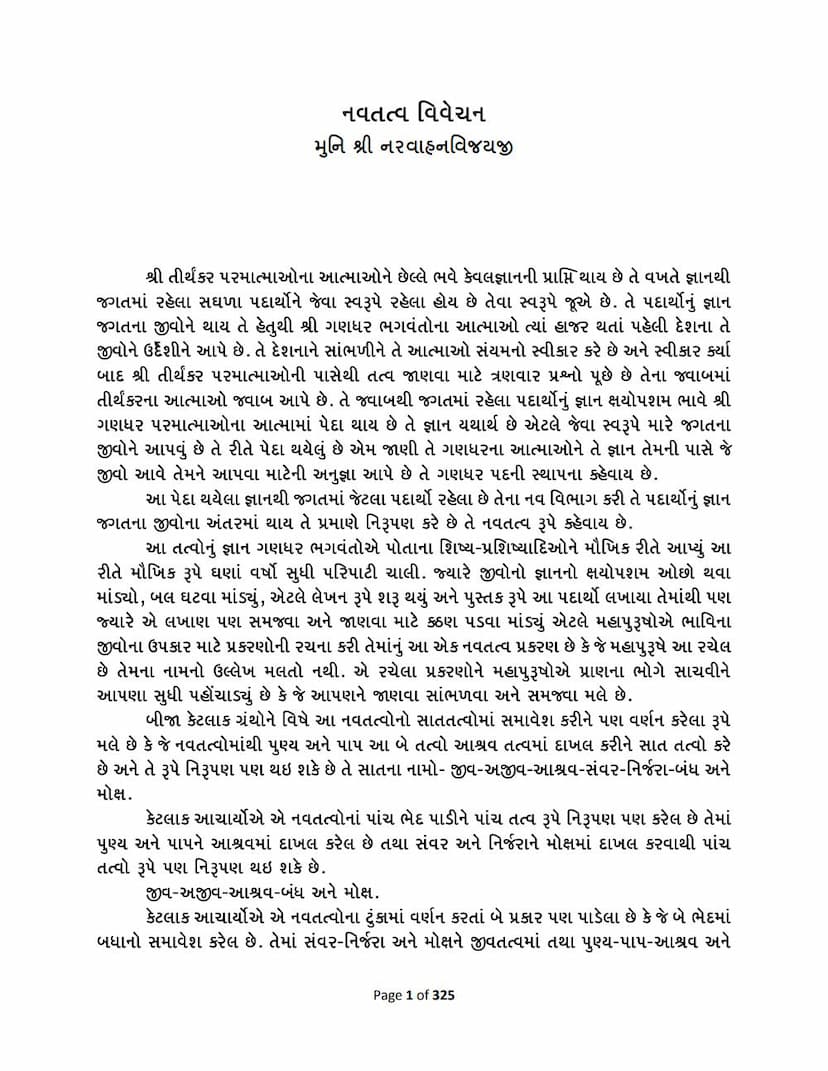Navtattva Vivechan
Added to library: September 2, 2025

Summary
The provided Jain text, "Navtattva Vivechan" by Narvahanvijay, offers a comprehensive explanation of the nine fundamental principles (Navtattva) in Jainism. The text traces the origin of these principles back to the teachings of Tirthankaras, which were then systematized by Ganadharas. It explains that these nine tattvas are divisions of all the substances present in the universe, intended to impart their knowledge to living beings.
The text then details how this knowledge was passed down orally for many years until, with the decline of spiritual potency (kshaya-upaśama) in beings, it was recorded in written form. When these writings became difficult to comprehend, great souls composed further explanatory chapters, including this "Navtattva Prakaran," whose author is not explicitly mentioned. The text emphasizes that these teachings have been preserved for our benefit, even at the cost of the lives of the Mahapurushas.
It also notes that in some other texts, these nine tattvas are sometimes summarized into seven, by merging 'punya' (merit) and 'paap' (demerit) into 'ashrava' (influx of karma), leading to the seven tattvas: Jiva (soul), Ajiva (non-soul), Ashrava, Samvara (cessation of influx), Nirjara (shedding of karma), Bandha (bondage), and Moksha (liberation). Some acharyas have further condensed them into five tattvas by including punya and paap within ashrava, and samvara and nirjara within moksha, resulting in: Jiva, Ajiva, Ashrava, Bandha, and Moksha. Additionally, some acharyas have simplified it further into just two categories: Jiva (soul) and Ajiva (non-soul), by including samvara, nirjara, and moksha within the soul, and ashrava, bandha, punya, and paap within the non-soul.
The text then delves into the detailed classification of the Navatattvas, stating that there are 276 sub-categories in total: Jiva (14), Ajiva (14), Punya (42), Paap (82), Ashrava (42), Samvara (57), Nirjara (12), Bandha (4), and Moksha (9).
The text defines 'Tattva' as the specific nature or characteristic of a substance as perceived by omniscient beings. These nine tattvas are further categorized into three groups based on their applicability for spiritual progress:
- Śeya (Knowable): Jiva and Ajiva. These are to be known in their true nature.
- Heya (Avoidable): Punya, Paap, Ashrava, and Bandha. These are to be abandoned or overcome.
- Upaadeya (Adoptable): Samvara, Nirjara, and Moksha. These are to be attained and embraced.
The text elaborates on the importance of knowing Jiva and Ajiva, explaining that the soul's endless wandering (paribhraman) through various life forms is due to attachment and aversion. Understanding the causes of this transmigration is crucial for liberation. The duration of this transmigration is described in detail for different types of beings (Sukshma, Bādar, Indriya Jiva), illustrating the vastness of time spent in the cycle of birth and death. Knowing the Ajiva tattva helps in understanding the realms and substances encountered during this journey.
The text further discusses the concepts of Punya and Paap as avoidable, explaining that while Punya may lead to temporary happiness, it must ultimately be relinquished on the path to Moksha. Paap, being the cause of suffering, is clearly to be abandoned. Ashrava (influx of karma) and Bandha (bondage of karma) are also explained as avoidable as they perpetuate the cycle of birth and death.
Conversely, Samvara (cessation of karma influx), Nirjara (shedding of karma), and Moksha (liberation) are presented as adoptable. Samvara is achieved by stopping new karmas, Nirjara by destroying existing karmas, and Moksha is the state of complete liberation from all karmas, leading to the soul's pure and eternal existence.
The text also touches upon the classification of these tattvas into 'Rupi' (having form, color, smell, taste, touch) and 'Arupi' (formless). It details the complexities of the soul's transmigration, the durations involved, and the intricate classifications of beings based on senses, life spans, and states of consciousness. The descriptions of the twelve types of beings, the states of sentient beings, and the various classifications of life forms, including one-sensed beings to five-sensed beings, highlight the vastness of the Jain cosmology.
The author then elaborates on the six essential attributes of the soul (Jiva): knowledge, perception, conduct, austerity, energy, and application. Each of these attributes is discussed in detail, with particular emphasis on the various types of knowledge (Mati, Shruta, Avadhi, Manahparyaya, Kevala) and how karmic obstructions limit their manifestation. The text also explains the concept of 'prayati' (capabilities or functions), such as the formation of body, senses, speech, and mind, and how these are dependent on external karmic matter (pudgala).
The book further discusses the nine tattvas in relation to physical and non-physical categories, detailing the characteristics of the six substances (Dravya) in Jainism – Dharma, Adharma, Akash, Pudgala, Jiva, and Kala – and their respective sub-categories. It elaborates on the nature of Pudgala (matter) with its qualities like color, smell, taste, and touch, and provides scientific-like explanations of the universe, time, and the cycle of existence.
The text meticulously breaks down the tattvas into various classifications, providing numerical breakdowns for the sub-categories of each tattva, emphasizing the logical and systematic approach of Jain philosophy. It details the stages of spiritual development and the path to liberation, highlighting the importance of understanding these principles for spiritual purification and ultimate salvation. The work also explains the different types of karma, their effects, and the methods for their destruction, underscoring the karmic law of cause and effect. The detailed description of the fourteen types of souls and their sub-classifications, the twelve types of bhavanas (contemplations), and the meticulous explanation of the nine tattvas demonstrate the comprehensive nature of the text in conveying Jain philosophy.
The text concludes by reiterating the importance of these nine principles for understanding reality and achieving spiritual liberation. It serves as a foundational text for grasping the core tenets of Jainism.